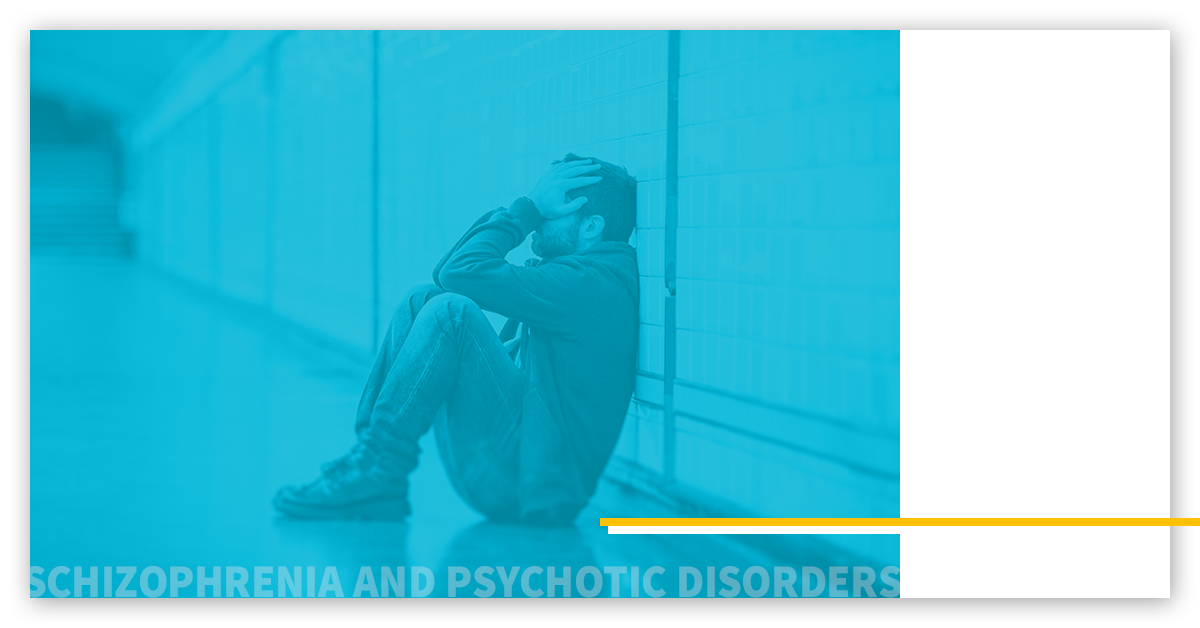Psychotic Disorders

LISTEN TO THIS ARTICLE:
Psychotic disorders encompass a range of disconnection from reality that stretches from atypical behaviors and problems socializing to a total break, complete with hallucinations, delusions, and disorganized thoughts and behaviors.
What are Schizophrenia and Psychotic Disorders?
To understand how Schizophrenia and Psychotic Disorders affect people, it is important to understand the several key symptoms that characterize these disorders. These include delusions, hallucinations, disorganized speech and thoughts, abnormal physical movements or behavior, and negative symptoms.
Delusions
Delusions are strong beliefs that patients have and are unwilling to change even in the face of evidence against them. There are several different types of delusions. There are grandiose delusions, in which patients believe they have power, exceptional abilities, or great riches. People also experience referential delusions, where they think unrelated events or things on television or radio are messages directed at them.
People with persecutory delusions believe that other people or specific groups (like law enforcement or government agencies) are monitoring them, following them, or trying to hurt them. Erotomanic delusions lead a person to believe someone else, even someone they have never met, is in love with them. Others also believe their thoughts are being altered by something outside them, that ideas are inserted or removed, or that their bodies, minds, and actions are being controlled by a powerful entity. These are examples of delusions that are strikingly out of the ordinary, which cannot make sense in any real-world context.
Hallucinations
Hallucinations are sensory experiences (like sights, sounds, or smells) that a patient feels without any external source. These are very real and very hard to ignore, and people frequently respond to them. Auditory hallucinations are most common in these disorders, and “command” hallucinations, where a person hears a voice telling them to do something, are a good example. These are particularly disturbing as they can lead people to do things they would not normally do, such as hurt themselves or others.
Disorganization
The disorganized thinking that is so characteristic of psychotic disorders is most apparent in how someone talks. People with disorganized speech will jump from one subject to another unrelated subject with little or no segue. The level of disorder can span from the occasional odd statement all the way to completely illogical speech that is known as “word salad”. This is often one of the earliest signs of an oncoming psychotic episode.
Abnormal behavior
Atypical behavior stretches a wide range of possible actions, all of which impair the ability to perform basic tasks and take care of themselves. The person can have lots of excess energy, appearing hyper or tense. On the other end of the spectrum is catatonia. This can appear both in psychotic disorders and in mood disorders like Bipolar Disorder or depression. Catatonia is a severe lack of physical or verbal reaction to outside stimuli. This person will speak and move very little or not at all. They sit in rigid or odd positions for extended periods of time.
Negative symptoms
Though they are not as outwardly apparent as these other symptoms, negative symptoms are very debilitating and tend to be most resistant to treatment. Additionally, they are usually the first symptoms to appear in Schizophrenia. These symptoms are very similar to the social withdrawal and lack of interest in activities that are so characteristic of depression. The most prominent of the negative symptoms is a significant lack of emotional reaction even in a wide variety of trying situations. Facial expressions, tone of voice, eyes, and gestures also convey a concerning numbness. The person will often speak very little. They won’t show much interest in spending time with others in a social or intimate setting. There will often be minimal interest in hobbies, work, or group activities. A common component of this is called “anhedonia”, an inability to take pleasure in previously enjoyed interests.
Psychotic disorders include Schizotypal Personality Disorder, Delusional Disorder, Catatonia, Brief Psychotic Disorder, Schizophreniform Disorder, Schizophrenia, and Schizoaffective Disorder. People with Schizotypal Personality Disorder have a deeply ingrained pattern of odd behavior and problems developing and maintaining interpersonal relationships. Delusional Disorder and Catatonia are unique in that those people display only the one titular psychotic symptom and no others. Brief Psychotic Disorder and Schizophreniform Disorder are essentially short-term versions of Schizophrenia with little or no impairment in daily life. Schizophrenia is a severe psychotic disorder with powerful symptoms, and someone with this disorder will have significant difficulties functioning. People with Schizoaffective Disorder suffer the symptoms of Schizophrenia in conjunction with a mood episode such as major depression or mania.
Who gets Schizophrenia and Psychotic Disorders?
Brain injury
Any damage to the brain can put a person at higher risk for developing psychotic symptoms. This can include things as basic as head injury or stroke, which can cause some symptoms. Injury to the brain while it is still developing is the most common type of insult associated with psychotic disorders. Prenatal infection, maternal diabetes, malnutrition, and oxygen deprivation during birth can also contribute.
Mood and psychotic disorders
People with Major Depressive Disorder or Bipolar Disorder can develop psychotic symptoms as part of those disorders, and those can progress even further. People who have had Brief Psychotic Disorder or Schizophreniform Disorder are at higher risk of going on to develop Schizophrenia.
Substance abuse
Stimulants like amphetamines and cocaine as well as phencyclidine (PCP) are notorious for having the potential to cause hallucinations and delusions in people who use them habitually. Withdrawal from alcohol and sedatives can also induce hallucinations. A toxicology screen easily reveals the cause of psychosis in these people. Heavy marijuana use at a young age can precipitate a psychotic episode in people with a certain genetic propensity.


 Learn
Learn Find Help
Find Help